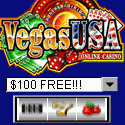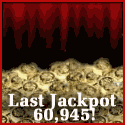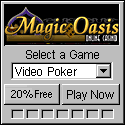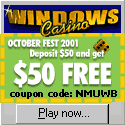Tips and strategies to help make you a winning casino player
Game
Rules
Learn: Blackjack, Baccarat, Craps, Roulette, Slots, Video Poker, Pai Gow Poker,
Texas Hold'em, Caribbean Stud, Let It Ride, Casino War, Big Six, Sic Bo (NEW!)
Systems Gallery
Win more, more often with proven betting methods from the systems gallery
Order
Form
A secure on-line order form to purchase products advertised by Let's Talk
Winning.
Playing Online
All about gambling at online casinos. Find out where the best deals are
Best Casino Bonuses - NEW!
The best collection of on-line casino bonuses, where you can
cash $802 on your sign-up.
Links
and Things
Sign our guestbook, refer a friend, link to other gambling sites.
Gambling News - NEW!
Latest Gambling News - updated daily including gambling
articles, joke of the day and a gambling dictionary.
Newsletter
Click above to read the current edition of our
weekly newsletter. Then get your own free subscription right here. Enter your e-mail
address for immediate delivery of an introductory issue, including a FREE ROULETTE SYSTEM:
Please tell all
your friends about it.
On-Line Forum
Post a gambling question or opinion - get an answer .
. .
 Wanna Win At Slots? Click
Here!
Wanna Win At Slots? Click
Here!


It's now $50 bonus every month!
===========================================
Thursday, December 26, 2002
Gambling with a Stock Market Approach
Hello everyone,
I hope you enjoyed your Christmas evening. I certainly did very much. You see, I'm Jewish, but our Christian friends invite us over their Christmas and Easter dinner and we invite them over for our Passover and Rosh Hashanah (new year) dinner and we have a great time together. I believe that if all the 3 religions of the holy city of Jerusalem would behave this way, most of today's religious conflicts would have been resolved and the world would have been a much more peaceful place to live. It's a matter of attitude and good will.
Now, to our today's subject, which explores gambling strategies with a stock
market approach. Point and Figure charting has been around for nearly
one hundred years as a stock charting system. Its main function is to
clearly show previous high and low prices of stocks. This makes it easy to
see when a stock makes a new high or anew low - the breakout. The reason
that this is important is that a stock making a high is expected to
go higher and conversely, a stock making a new low is expected to go lower!
Tracking
trends can be profitable.
When used to chart a stock, there is no time line on the horizontal "x" axis
as is the
usual case with a stock "bar" chart. The stock analyst using a P&F chart is
mainly interested in viewing graphically the current price of the stock in
relation to its prior highs and lows. You can readily see where the lows and
highs occurred in relation to the current price. An "X" is entered when the
stock advances in price and an "O" is entered when a stock declines in
price. Xs and Os are entered in alternate columns. In no case do you ever
have Xs and Os in the same column. When a price has topped out at a price,
you move over one column to the right, drop down one square (representing
the lower price that has gone down by one unit) and enter Os as the price
moves down. This continues until a new low is reached and the price reverses
by three squares (units). At this point, you move over one column and up one
square and start entering Xs as long as the price is advancing.
No reversal entry is made unless a move of at least three units is made. A
unit could be one dollar, one half dollar or one eighth of a dollar or any
other unit depending on the price of the stock. The P &F charts are normally
made on graph paper with small squares. Each square represents a unit of
price. When prices go up, we use Xs to indicate the price increases. When
prices go down, we use Os to indicate the price decreases. Vertical columns
of Xs and Os alternate. We move one column to the right each time there is a
change in direction - from up to down or vice versa. Xs and Os never appear
in the same column. Each column represents an up move or a down move. A
column cannot represent both.
In charting stocks there are never less than three squares of Xs or Os in a
column. Therefore, you can see that it takes a price reversal of at least
three dollars to record a
reversal in a stock price's direction when each square represents one
dollar.
The following example is given of a stock chart recorded in the P&F method:
40
X
39
X
38
X
37
X
36
X <Breakout -buy point
35 X X
X
34 X O X O X
33 X O X O X
32 O
O
31
< Downside breakout - sell point
The stock price chart is started at the price of 33. This represents the
price when you decided to start charting the stock by the P&F method. The
time period involved does not show up on the chart at all. The price
advances from 33 to 35 (Xs go up and Os go down). At the price of 35, the
price turned down to 34, then 33, and then 32. When the direction changes
from up to down or down to up, you move over one column to the right and one
square down or up as appropriate.
It should be noted that the decline to 32 would not be posted until the
price actually went down by three units - in this case three dollars. The
next move was up from 32 to 35 where it was turned back once again. Notice
that the resistance on the upside is at 35 and the support on the downside
is at 32. Once again the price declines to 32 and once again it receives
support here and the decline is stopped. On the third advance to 35, the
price breaks through the "congestion zone" (commonly called a "breakout" in
stock market terms) and goes to 40. Notice that if a move of three units,
either up or down, has occurred, then any additional move in that direction
is posted as the price moves by one unit or one square.
The breakout at the price of 36 is the buy signal in terms of the stock
speculator. This type of breakout will also be the signal to bet when
applied to roulette, baccarat, or craps. Once an upside breakout has
occurred, the stock is held until a breakout on the downside has occurred.
Now, lets say that you are playing baccarat or craps. Instead of posting Xs
representing rising prices or Os representing lower prices, you post Xs
representing wins for banker (or passes) and post Os representing losses for
bank (or conversely wins for player or don't pass). Each ,"X" represents a
win for bank or pass and each "O" represents a win for player or don't pass.
The key idea is to use the P&F chart to determine the trend. The signal to
bet on banker is when a higher level has been attained than on previous
levels which have been reached. The levels in this case (as price levels are
measured in the case of stocks) are not considered.
It is simply the relationship of the wins and losses which are considered.
The truly amazing thing about its use in gambling is the fact that the
patterns made by the gambling decisions cannot be differentiated from that
of stock charts. They are that similar. You can test this idea by tossing a
coin and recording heads and tails. You too may be amazed at the results you
achieve.
Consider the following pattern using Xs for Banker and Os for Player
decisions:
X
X <Shows winning bet (1st bet)
X <Breakout signal --bet on bank next decision
X X X
X O X O X
X O X O X
O O
There are differences
in how the P&F is played for gambling purposes. First of all, you do not
wait for a change in direction of three units (three consecutive bets) to
occur to post the change as with stocks. You post an X for the bank or a O
for player each and every play. This procedure tracks the changes faster and
simplifies the record keeping.
Secondly, changes in direction - that is if bank won the previous decision
and player wins the next decision, the decision is recorded in a new column
to the right. Consequently, many columns may have only one bet
recorded in it. A pattern such as the following frequently develops:
X
X X X
X X (The X and 0 are alternating wins for banker and
player)
X O
O O O O
X O X
X O X
X
The "X" represents a win for bank (moving up) and the "O" represents a win
for player (moving down). Do you see a pattern here? The author bets the
"before last" alternating patterns. The above pattern shows the
following win sequence: bank, player, bank, player, bank, player, bank,
player, bank, player, bank. You may play the alternating bank and
player decisions after having observed four alternating decisions. This is a
side bet, however, to the major thrust of the Point & Figure system. Played
III the normal way, however, this pattern keeps you even If you are playing
flat bets. That is, if you are in a major up trend (bank is winning) you win
on bank, lose on player, or vice versa, until the major trend resumes or
reverses. If you played the alternate bank and player pattern, you have an
additional profit.
You start betting and continue as long as the breakout bets are winning. You
stop betting only when a breakout occurs in the opposite direction. At that
time, you reverse your bets. If you were betting on bank and a downside
breakout occurred, you would then bet on player.
By betting based on the trend breakouts, you greatly improve your chances
for a winning session. You will be betting only in the direction of the
winning trend.
A variation of the play described above is to play the breakouts only. By
this I mean you quit playing bank or player as soon as you have one loss. If
an upside breakout occurs for bank, you bet bank until you win. This could
be on your first bet or your tenth bet. It makes no difference. You resume
betting only when anew breakout occurs. This could be in either direction -
bank or player or pass or don't pass.
Here is an example:
X
X O O
-Signal to stop betting
X O X
-Signal to bet bank
X O X O
X O X O
X O X O
X O X O
Now let us examine the above situation. The X in bold print shows where the
signal to start betting bank occurred. You win the next two bank decisions.
But once the first player decision wins you immediately stop betting bank
and wait for a new breakout. The O in bold print shows the first loss to
player that is your signal to stop betting bank and stand aside waiting for
a new breakout. If you continued betting bank, you could be betting for the
next six bets and lose and yet be within the trend indicated by the
breakout. So, you can quit while winner and start betting when a new pattern
develops. This is a method to avoid the large thick "congestion" zones
whereby the number of decisions from the low side of the zone to the high
side consists of many decisions. Many times this zone is only two or three
decisions thick and does not represent a danger. In other words, if bank has
won ten consecutive decisions, and player starts to win, it would take ten
consecutive player decisions to occur before you would have a new "breakout"
signal to start betting player. This situation occurs more often than you
would believe. This is a safety valve to help you keep wins and to lessen
your potential drawdowns.
You may experiment and define other rules with which to play this time
method of tracking stock trends.
For a more serious stock market system, you should strongly consider TTS - the Trade Tuner system, that is discounted by $250 until midnight December 31, 2002.
And for the best Baccarat system ever, consider PowerPlay Baccarat 2002 - Level 4, which doesn't stop getting good reviews at the discussion forum and is also discounted by $250 until the end of the year.
This is the last week to take advantage of the special year-end savings: all systems at the Systems Gallery are discounted by 25% until midnight December 31, 2002. A special secure order form is available for you that has the discounted prices. Click here to take advantage of the great year-end savings.
If you wish to pay by PayPal, click on the following link, that also includes the discounted prices.
You can also place your orders by fax (603) 687-2257, or by a Western Union transaction by sending the control number to webmaster@letstalkwinning.com, or simply by phone by calling (514) 487-1066, where further special deals can be negotiated.
Wishing you and your families a very happy, healthy and prosperous new year.
Until next week,
Izak
If you missed any newsletter, click here for an archive.















